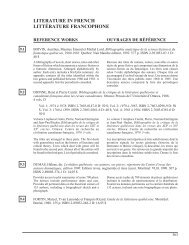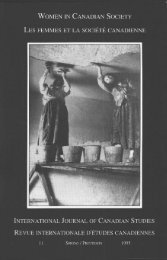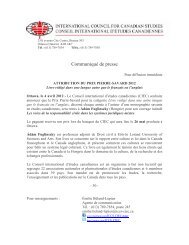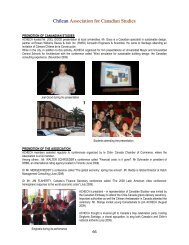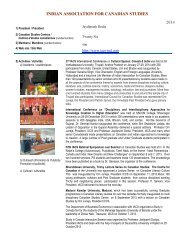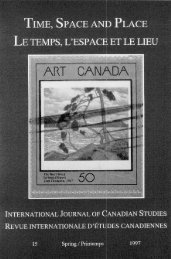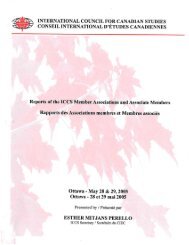The Jordans. Remembered <strong>and</strong> Invented Pastplural, p<strong>la</strong>ces <strong>in</strong>dividual <strong>in</strong>cident <strong>in</strong> a body of collective experience. Bothnovels provide an answer to Christa Wolf’s repeated question which forms theleitmotif of K<strong>in</strong>dheitsmuster: “How did we become what we are today?” (MC209) 32Notes1. Christa Wolf. A Model Childhood (1983). Trans. U.Mol<strong>in</strong>aro <strong>and</strong> H.Rappolt, London:Virago 1988, p. 338. (My emphasis; further references are <strong>in</strong>corporated <strong>in</strong> the text [MC]).2. See “Interview with Alice Munro", conducted by Kay Bon<strong>et</strong>ti for the American Audio ProseLibrary, June 1987. (AAPL 7052, IBSN 1 55644 187 8)3. For the m<strong>et</strong>aphor, I am <strong>in</strong>debted to: J.R. (Tim) Struthers. Intersect<strong>in</strong>g Orbits: a Study ofSelected Story Cycles by Hugh Hood, Jack Hodg<strong>in</strong>s, C<strong>la</strong>rk B<strong>la</strong>ise <strong>and</strong> Alice Munro. PhDDiss., University of Western Ontario,1982.4. Christa Wolf was born <strong>in</strong> 1929, Alice Munro <strong>in</strong> 1931. Lives of Girls <strong>and</strong> Women appeared <strong>in</strong>1971, K<strong>in</strong>dheitsmuster <strong>in</strong> 1976. Upon my request, Christa Wolf <strong>in</strong>formed me that Munro’snovel was unknown to her <strong>and</strong> that any simi<strong>la</strong>rities could only be accidental.5. For the figure of speech, I am <strong>in</strong>debted to: Michael Riffaterre. Semiotics of Po<strong>et</strong>ry (1978).London: M<strong>et</strong>huen l980, p.83. In the quoted <strong>in</strong>stance, Riffaterre is referr<strong>in</strong>g to an extendedm<strong>et</strong>aphor <strong>in</strong> two poems by Ronsard <strong>and</strong> Magny.6. See Stanley Fish. Is There a Text <strong>in</strong> This C<strong>la</strong>ss? Cambridge, Mass.: Harvard UniversityPress, 1980.7. Manfred Pfister’s term “generische Systemreferenz” (which reflects <strong>and</strong> extends Gen<strong>et</strong>te’s“architextualité") refers to the same type of <strong>in</strong>tertextuality. (See M. Pfister. “ZurSystemreferenz”. In: Intertextualität. Formen, Funktionen, anglistische Fallstudien, editedby Ulrich Broich <strong>and</strong> Manfred Pfister, Tüb<strong>in</strong>gen: Niemeyer 1985, pp. 52 58.)8. David Williams repeatedly uses the term “artist novel” to rep<strong>la</strong>ce the more traditional term“Künstlerroman”. (See Confessional Fictions. A Portrait of the Artist <strong>in</strong> the CanadianNovel. Toronto: UTP 1991.) Whereas D. William’s artist-novels or confessional fictionscomprise the first-as well as the third-person form, F.K. Stanzel’s term “quasiautobiographical”novel refers exclusively to first-person narratives. In his description of thequasi-autobiographical novel Stanzel also uses the term “confessional form”. (See F.K.Stanzel. A Theory of Narrative. Cambridge University Press 1984, p. 98.)9. Christa Wolf. K<strong>in</strong>dheitsmuster (1976), Berl<strong>in</strong>: Aufbau-Ver<strong>la</strong>g 1983. Further references are<strong>in</strong>corporated <strong>in</strong> the text (KM).10. See David Goldknopf. The Life of the Novel, Chicago 1972, p. 33.11. Alice Munro. Lives of Girls <strong>and</strong> Women (1971). Scarborough, Ont.: Sign<strong>et</strong> 1974, p. 59, myemphasis. Further references are <strong>in</strong>corporated <strong>in</strong> the text (LG).12. This type of hypertextuality, an additional narrative dimension <strong>in</strong> Lives of Girls <strong>and</strong> Women(which has no parallel <strong>in</strong> K<strong>in</strong>dheitsmuster), constitutes one of the most conspicuous formaldifferences b<strong>et</strong>ween the two novels.13. The recovery of their physical hom<strong>et</strong>owns seems to be an <strong>in</strong>dispensable necessity for bothNelly <strong>and</strong> Del Jordan, documented <strong>in</strong> their repeated attempts at reconstruct<strong>in</strong>g the p<strong>la</strong>ce ofchildhood.14. “With such phrases [the I-narrator] refers to collective experiences that can be shared by allpeople”. (See W. Iser. Der implizite <strong>Les</strong>er. Kommunikationsformen des Romans von Bunyanbis Beck<strong>et</strong>t. München: Wilhelm F<strong>in</strong>k 1972, p. 209.)15. W. Iser’s orig<strong>in</strong>al terms are “der implizite <strong>Les</strong>er” <strong>and</strong> “der wirkliche <strong>Les</strong>er”. (See W. Iser.Der Akt des <strong>Les</strong>ens. Theorie ästh<strong>et</strong>ischer Wirkung [1976]. München: Wilhelm F<strong>in</strong>k 1984.)16. See F.K. Stanzel. A Theory of Narrative, p. 92.17. Alice Munro. “The Ottawa Valley”. In: Som<strong>et</strong>h<strong>in</strong>g I’ve Been Mean<strong>in</strong>g to Tell You (1974).Harmondsworth: K<strong>in</strong>g Pengu<strong>in</strong> 1985, p. 233, my emphasis.18. See John Moss. Sex <strong>and</strong> Violence <strong>in</strong> the Canadian Novel. The Ancestral Present. Toronto:M&S 1977, p. 64.83
IJCS/RIÉC19. I am quot<strong>in</strong>g this important statement <strong>in</strong> the German orig<strong>in</strong>al, because its trans<strong>la</strong>tion <strong>in</strong> AModel Childhood (“One must eventually break the silence about difficult th<strong>in</strong>gs.” p. 178) is<strong>in</strong>adequate <strong>and</strong> obscures Christa Wolf’s reference to Wittgenste<strong>in</strong>.20. Nelly Jordan repeatedly expresses her uneas<strong>in</strong>ess about the fact that the official GDR seesthe war as a consequence of western capitalist economy <strong>and</strong> ideology, thus exempt<strong>in</strong>g itself<strong>from</strong> any responsibility.21. W.R. Mart<strong>in</strong> has dealt with this topic <strong>in</strong> his essay “The Strange <strong>and</strong> the Familiar <strong>in</strong> AliceMunro”. In: Studies <strong>in</strong> Canadian <strong>Literature</strong> 7, no. 2 (1982), pp. 214-26.22. See F.K. Stanzel. A Theory of Narrative, p. 212.23. Alice Munro. Who Do You Th<strong>in</strong>k You Are? (1978), Ag<strong>in</strong>court, Ont.: Sign<strong>et</strong> 1979.24. Ulrich Broich <strong>and</strong> Ulrich Suerbaum have exam<strong>in</strong>ed this specific form of <strong>in</strong>tertextuality. (SeeUlrich Broich. “Zur E<strong>in</strong>zeltextreferenz.” In: Intertextualität. Formen, Funktionen,anglistische Fallstudien, edited by Ulrich Broich <strong>and</strong> Manfred Pfister, Tüb<strong>in</strong>gen: Niemeyer1985, pp. 48-52; <strong>and</strong> Ulrich Suerbaum. “Intertextualität und Gattung. Beispielreihen undHypothesen.” Ibid., pp. 58-77.) Suerbaum’s def<strong>in</strong>ition of this particu<strong>la</strong>r type of<strong>in</strong>tertextuality, “die Figuren werden fortgeschrieben”, applies to my statement, “Del Jordantraverses substantial p<strong>arts</strong> of Munro’s fiction”. It should be mentioned that Christa Wolf’soeuvre conta<strong>in</strong>s <strong>in</strong>terre<strong>la</strong>tions of a simi<strong>la</strong>r type: the first-person narrator of Nachdenken überChrista T. (a novel that appeared <strong>in</strong> 1968) may well be seen as a forerunner of Nelly Jordan.25. Alice Munro. “The Peace of Utrecht”. In: Dance of the Happy Shades (1968),Harmondsworth: K<strong>in</strong>g Pengu<strong>in</strong> 1987, p. 193, my emphasis.26. Alice Munro. “The Colonel’s Hash Res<strong>et</strong>tled”. In: the narrative voice, edited by JohnM<strong>et</strong>calf, Toronto: McGraw-Hill Ryerson, 1972, pp. 182-3.27. Ibid., p. 183, my emphasis.28. See K. Bon<strong>et</strong>ti, “Interview with Alice Munro”.29. See J.R. Struthers. “The Real Material: An Interview with Alice Munro”. In: ProbableFictions: Alice Munro’s Narrative Acts, edited by Louis K. MacKendrick, Downsview,Ont.: ECW Press 1983, p. 29.30. Nelly Jordan’s daughter <strong>and</strong> husb<strong>and</strong>.31. See H.R. Jauß. Literaturgeschichte als Provokation. Frankfurt 1970.32. Christa Wolf is referr<strong>in</strong>g to Friedrich Ni<strong>et</strong>zsche’s title Ecce Homo: Wie man wird, was manist. The <strong>in</strong>tertextual reference to a writer of the 19th century establishes a cont<strong>in</strong>uity thatreaches beyond the political implications of the novel. This textual sign seems to support an<strong>in</strong>terpr<strong>et</strong>ation that sees K<strong>in</strong>dheitsmuster as a parable of universal experience.84



